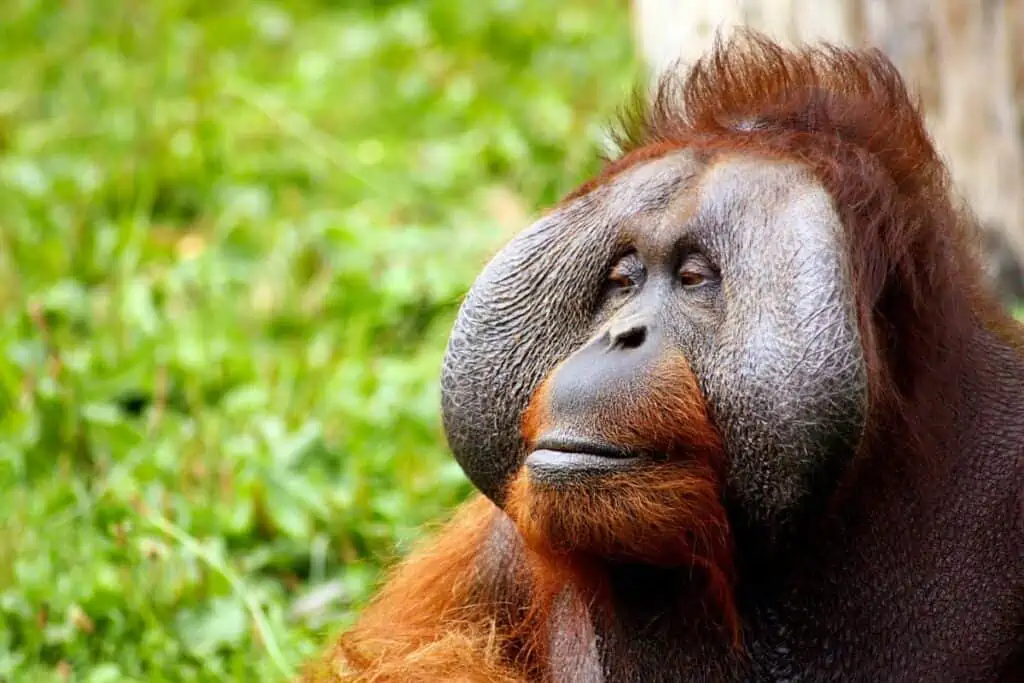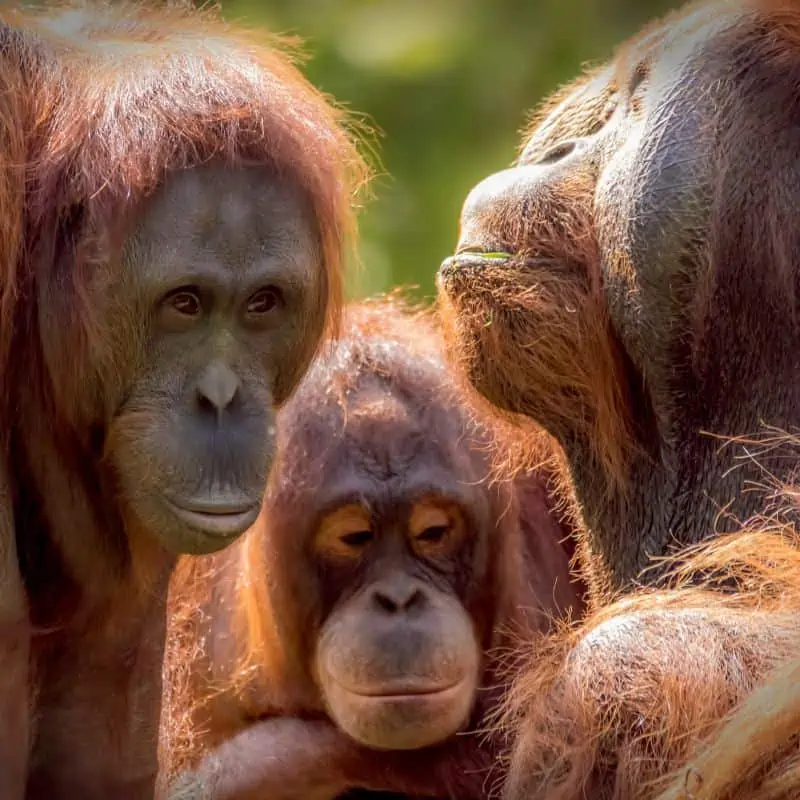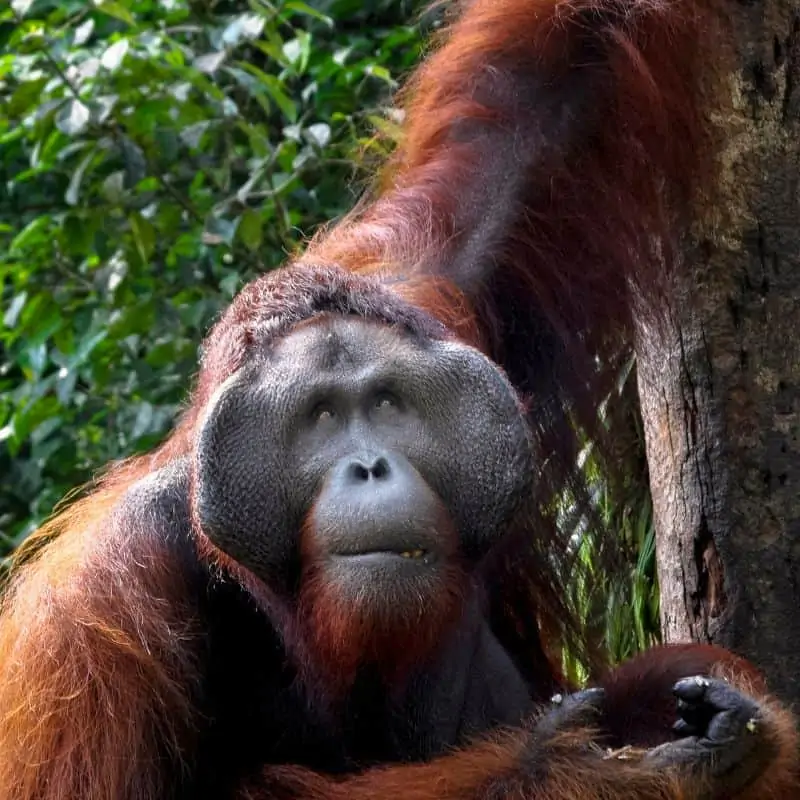Some orangutans have flanges on the sides of their heads, while others don’t. What’s the purpose of orangutan flanges, and why aren’t they universal?
Orangutan flanges are present in males of the species. This is true for Bornean, Sumatran, and Tapanuli male orangutans. The flanges appear when the ape reaches sexual maturity age, and no other dominant male is in its territory. Not all males have flanges, and females do not have flanges, either.
Are males with flanges superior to the ones without? What are they made of, and how are they developed?
Let’s take a look at this and more in this article.

What Are Orangutan Flanges Made Of?
Orangutan flanges are made of subcutaneous fibrous tissue and are only found in the dominant males of all three orang species.
This physical feature is brought about by an excess of testosterone in dominant males.
What Specific Purpose Do Orangutan Flanges Serve?
Orangutan flanges serve two primary purposes:
Female Attractant
Orangutan flanges are used as a visual signal advertising virility. This instantly makes the male with flanges more attractive to females.
Although orangs still go through a ritual courtship period, females who chance upon flanged males are more receptive to their advances.

Rival Deterrent
Flanged males are automatically viewed by lesser males as fiercer, stronger, and more dominant.
These cheek flaps, at a glance, make the flanged male appear larger.
Only Dominant Male Orangs Have Flanges
These orangutan cheek flaps only occur in dominant males who have established their territory and have been left unchallenged.
This is easy because the oversized cheek pads act as a visual deterrent.
Most males who encounter a dominant male with enormous cheek pads usually avoid confrontation.
Dominant male orangutans produce more testosterone than their submissive counterparts. The level of testosterone present dictates the probability of orangutan flanges appearing in the individual or not.
This is also why female orangutans do not develop these cheek pads.
When Do Orangutan Flanges Appear?
Orangutans are the slowest to mature in the great ape family. It takes 7 to 10 years for males to reach reproductive age.
And even then, they may not develop these impressive cheek pads.
Orangutans display a unique form of bimaturism that no other great ape displays. This is the case of flanged and unflanged males.
A young male will exhibit dominance over his peers early on, indicating that they are a candidate for developing flanges.
Upon reaching sexual maturity and without the presence of a dominant male, they may develop the beginnings of these cheek extensions.
This growth is rapid, and within a year, a full set of cheek flaps will appear on the face of the male orang. This is what happens in perfect conditions, provided that:
- There is no dominant male present within its immediate vicinity or
- The male orang in question is a captive in the zoo where virtually no male orang can challenge it.
Once a dominant male is absent within the territory, other males start developing flanges until a new alpha is established.
When this happens, flange suppression happens, and other males remain unflanged.

Why Do Some Male Orangutans Not Have These Flanges?
The presence of flanges points to a surplus of testosterone during the male’s sexual maturity development.
There is evidence that a rapid increase in testosterone within a small window of time encourages the flaring out of these cheek pads.
This occurrence can be hindered if there is the presence of another dominant male within the orang’s range.
A dominant male can challenge the upstart and diminish its development to become more submissive to the adult with orangutan flanges.
Evidence of this is shown in the number of sexually mature unflanged orang males near the domain of a dominant male.
Although these unflanged males can still mate and father offspring, their testosterone level is below that of the dominant male.
When the dominant male establishes its presence and territory, unflanged males often just abandon their position and flee.
Do Flanges Occur In All Orang Species?
Orangutan flanges are present in all three orang species’ dominant male representatives.
The three species we refer to include the Sumatran, Bornean, and Tapanuli orangutan.
Do Female Orangutans Prefer Males With Flanges?
Studies have shown that female orangs prefer males with orangutan flanges. The larger the orangutan flanges, the more readily the females accept the male as a mate.
The reason for this, as mentioned above, is that the orangutan flanges signal to all other orangs in the vicinity that the owner of the cheek pads is a strong, dominant male.
Female orangs prefer these males because they can hold onto territory, are fertile, and can protect them from threats.
Males with orangutan flanges can enjoy having multiple mates within their territory. This increases the probability of siring offspring and passing on their genes.
This does not prevent unflanged male orangs from mating with females. Females may or may not resist the advances of an unflanged male based on the probability of getting pregnant.
Females who have not entered oestrus will allow an unflanged male to mate as they are certain it will not result in pregnancy.
Final Thoughts On Orangutan Flanges
Orangutan flanges are a physical feature signaling the testosterone level of male orangutans; this deters rivals and attracts females.
Not all males develop these cheek pads, as only the dominant male in a territory will grow them. When the males reach sexual maturity, flanges can grow quickly and fully form within a year.
If we are to see more Orangutans with these impressive cheek pads, we need to protect them from the very real threat of extinction.

FAQs
Do Female Orangutans Develop Flanges?
No. Female orangutans don’t develop flanges as they have very low testosterone levels. The physical feature they share with males is the development of a throat sac for making long calls.
Why Don’t Young Male Orangutans Have Cheek Pads?
Young male orangs who haven’t reached sexual maturity don’t develop orangutan flanges until a massive amount of testosterone is delivered to their system. Only then can they have impressive cheek pads on their faces. Sometimes this might even be subdued if a dominant male is present.
Do Orangutan Flanges Stay Forever?
No. There is no reason for a male to remain as big as he is throughout his life. These cheek pads often first develop in time with the mating season. It remains on the male’s face between 2 to 7 years, enough time for the flanged male to father numerous offspring.
